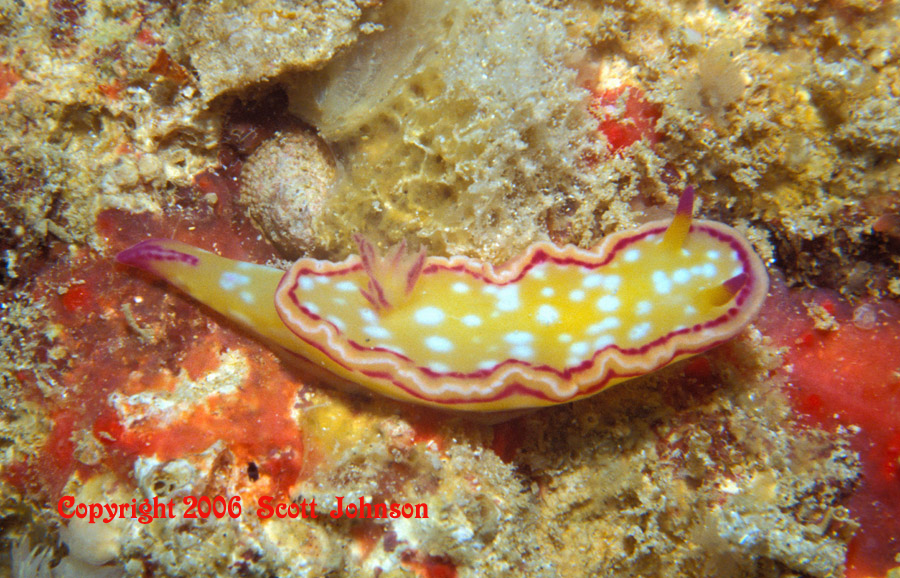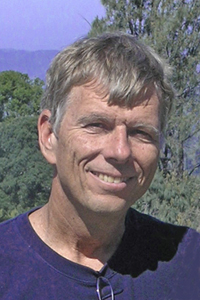 |
Glossodoris sp.
French Frigate Shoals, Hawaiian Islands. Found by Stan Jazwinski Size 40 mmPhoto courtesy of Scott Johnson (not taken in situ)
Glossodoris sp.
The main Hawaiian Islands form a chain of large or relatively large volcanic islands stretching from Hawaii in the southeast to Kauai and Niihau in the northwest. But the Hawaiian chain doesn’t end at Kauai. It continues on in a roughly straight line of about 10 islands, almost atolls, and atolls for another thousand miles. This stretch is called either the Leeward Hawaiian Islands or the Northwestern Hawaiian Islands. The first four are small volcanic islands or have small spires of volcanic basalt still showing above the surface of the water and surrounding coral reef (when present). The rest are all calcareous islands and reefs, and the last three, Pearl and Hermes Reef, Midway, and Kure, are pretty much typical atolls. You can kind of see in this chain the evolution of an atoll from a volcanic mountain over time. The hot spot in the sea floor is still building the southeastern island of Hawaii (as well as Loihi, the underwater mountain slowly rising southeast of Hawaii that should pop above the surface of the water in a few tens of thousands of years). About 25 million years ago, Midway and Kure were over the hot spot now occupied by Hawaii and Loihi. In the time since, while the Pacific Plate has crept slowly northwest, their original large volcanic islands have eroded and sunk beneath the waves, leaving Midway and Kure atolls, coral and algae caps that have managed to grow fast enough to stay at the surface while the weight of the basaltic mountains underneath continue to push downward into the thin sea floor crust.
The Leewards have always been pretty hard to get to, but nowadays it is even harder. As of 2006, the entire chain beyond Kauai now makes up the Northwestern Hawaiian Islands National Monument ; the islands are now protected and travel to them takes special permission that is not easily obtained. Occasional research expeditions still manage to make the trip and Midway may still be open for visitation.
On one research trip in 1983 to French Frigate Shoals, the third island group up the chain, one researcher spotted this unique chromodorid. Knowing my interest in unusual sea slugs, he brought the specimen alive back to Oahu, where these photos were taken.
In shape, this species is reminiscent of some species of both Glossodoris and Ceratosoma . Calling it a Glossodoris is a guess.
Although the pictures pretty well speak for themselves, here are my notes on the living animal. The body measures about 40mm in length and is elongate oval and high-sided, with a relatively narrow undulating margin. The dorsum and sides are bright lemon yellow with irregular-sized white spots. The margin is white at the edge; above and below the white margin is a slightly wider submarginal band of cream yellowish white, followed by a line of reddish purple. Oral tentacles are small, conical and yellow, slightly purple at the tips. The foot margin and tip of the tail are red purple, similar to that on the mantle margin. The rhinophore club is purple, with less of a reddish tint than on the margin. Gills are unipinnate, and have rather narrow pointed stalks with relatively wide translucent pinnae. Gill rachides are the same shad of purple as the rhinophores. An egg mass deposited in captivity was pink.
Another angle of the same individual is here .
Despite considerable nudibranch interest by a number of divers over the past 40 or more years, this animal has apparently not yet turned up in the main Hawaiian Islands. Nor did I find it at Kure Atoll, the last island group at the end of the Hawaiian chain, on a couple of trips I made there in 1979 and 1980. It may be restricted to the central part of the northwestern chain. But you never know. Maybe one of these days some stray larvae will settle out around Kauai, Oahu, or one of the other main islands. Hawaiian divers, keep your eyes open for this one. It is certainly an undescribed species.
Kwajalein Atoll
Dec. 2006

In the early 80s, Scott worked for several years at the Mid-Pacific Research Lab on Enewetak Atoll, Marshall Island, finally being forced to leave only when lack of funding drove the lab out of existence. Wanting to return to the Marshalls but aware there weren't many jobs (like zero) available for nudibranch biologists in the area, he switched tracks to computer technology, which ultimately helped he and his wife Jeanette obtain jobs in 1988 as contractors on a US military base on Kwajalein Atoll. They've been there ever since, playing unix system administration or CAD mapping in their "day" jobs but spending as much time as possible in the 80-85 degree F water. |
Contact Scott at uwkwaj@yahoo.com
WEBMASTER'S NOTES : What a great way to usher in the New Year with Scott's BOW and Francis Pellet's super photo on the home page! Then to top it all, Alan Grant has a PNG video to offer in celebration of the New Year! It doesn't get much better than that to quote Chet Tussey! I would like to take this opportunity to thank everyone who in 2006 contributed to the site either in images or expanded knowledge of our sea slug friends.
Michael Miller
Webmaster
San Diego, Calif
